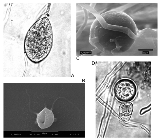
Pythiaceae
Encyclopedia
Pythiaceae is family
of water mould
s. The family includes plant pathogenic fungus-like organisms in the genus Phytophthora
; as well as serious plant and animal pathogen
s in the genus Pythium
.
Family
In human context, a family is a group of people affiliated by consanguinity, affinity, or co-residence. In most societies it is the principal institution for the socialization of children...
of water mould
Water mould
Oömycota or oömycetes form a distinct phylogenetic lineage of fungus-like eukaryotic microorganisms . They are filamentous, microscopic, absorptive organisms that reproduce both sexually and asexually...
s. The family includes plant pathogenic fungus-like organisms in the genus Phytophthora
Phytophthora
Phytophthora is a genus of plant-damaging Oomycetes , whose member species are capable of causing enormous economic losses on crops worldwide, as well as environmental damage in natural ecosystems. The genus was first described by Heinrich Anton de Bary in 1875...
; as well as serious plant and animal pathogen
Pathogen
A pathogen gignomai "I give birth to") or infectious agent — colloquially, a germ — is a microbe or microorganism such as a virus, bacterium, prion, or fungus that causes disease in its animal or plant host...
s in the genus Pythium
Pythium
Pythium is a genus of parasitic oomycete. Most species are plant parasites, but Pythium insidiosum is an important pathogen of animals...
.
Lifecycle
- Live on land (terrestrial), and in water (aquaticAquatic ecosystemAn aquatic ecosystem is an ecosystem in a body of water. Communities of organisms that are dependent on each other and on their environment live in aquatic ecosystems. The two main types of aquatic ecosystems are marine ecosystems and freshwater ecosystems....
), and a combination of the two, (amphibious) - Live as deadly parasites, causing some serious plant and animal diseases when terrestrial.
- The diploid (2N) life stage predominates, with a short haplophase initiated during sexual reproductionSexual reproductionSexual reproduction is the creation of a new organism by combining the genetic material of two organisms. There are two main processes during sexual reproduction; they are: meiosis, involving the halving of the number of chromosomes; and fertilization, involving the fusion of two gametes and the...
as well as asexual reproductionAsexual reproductionAsexual reproduction is a mode of reproduction by which offspring arise from a single parent, and inherit the genes of that parent only, it is reproduction which does not involve meiosis, ploidy reduction, or fertilization. A more stringent definition is agamogenesis which is reproduction without...
(homothallism predominates in the Family) to fuse gameteGameteA gamete is a cell that fuses with another cell during fertilization in organisms that reproduce sexually...
s.
Reproduction
- The sporangia may germinate via a germ tubeGerm tubeA germ tube is an outgrowth produced by spores of spore-releasing fungi during germination.The germ tube differentiates, grows, and develops by mitosis to create somatic hyphae....
or by release of motile zoosporeZoosporeA zoospore is a motile asexual spore that uses a flagellum for locomotion. Also called a swarm spore, these spores are created by some algae, bacteria and fungi to propagate themselves.-Flagella:...
s, depending on the species and the environmental conditions.
Economic Importance
- Some PythiumPythiumPythium is a genus of parasitic oomycete. Most species are plant parasites, but Pythium insidiosum is an important pathogen of animals...
species cause "damping-off" diseases in young plants (seedlings).

